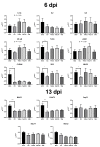Effects of Tannic Acid Supplementation on Growth Performance, Oocyst Shedding, and Gut Health of in Broilers Infected with Eimeria Maxima
- PMID: 35681844
- PMCID: PMC9179276
- DOI: 10.3390/ani12111378
Effects of Tannic Acid Supplementation on Growth Performance, Oocyst Shedding, and Gut Health of in Broilers Infected with Eimeria Maxima
Abstract
The purpose of this study was to evaluate effects of tannic acid (TA) on growth performance, fecal moisture content, oocyst shedding, gut permeability, lesion score, intestinal morphology, apparent ileal digestibility, and the antioxidant and immune system of broilers infected with Eimeria maxima. A total of 420 one-day-old broilers were distributed to five treatments with seven replicates of 12 birds. The five treatments were the (1) sham-challenged control (SCC; birds fed a control diet and administrated with PBS); (2) challenged control (CC; birds fed a control diet and inoculated with E. maxima); (3) tannic acid 0.5 (TA0.5; CC + 500 mg/kg TA); (4) tannic acid 2.75 (TA2.75; CC + 2750 mg/kg TA); and (5) tannic acid 5 (TA5; CC + 5000 mg/kg TA). The TA2.75 group had significantly lower gut permeability compared to the CC group at 5 days post-infection (dpi). Supplementation of TA linearly reduced oocyst shedding of E. maxima at 7 to 9 dpi (p < 0.05). At 13 dpi, the TA2.75 group had significantly greater apparent ileal digestibility (AID) of dry matter (DM) and organic matter (OM) compared to the CC group. At 13 dpi, supplementation of TA linearly increased jejunal villus height (VH). Thus, this study showed that supplementation of TA at levels of 500 to 2750 mg/kg has the potential to be an anti-coccidial agent against E. maxima in broilers.
Keywords: Eimeria maxima; broilers; gut health; oocyst shedding; tannic acid; tannins.
Conflict of interest statement
The authors announce that the research was conducted in the absence of any commercial or financial relationship.
Figures


Similar articles
-
Antimicrobial and immunomodulatory effects of tannic acid supplementation in broilers infected with Salmonella Typhimurium.Poult Sci. 2022 Nov;101(11):102111. doi: 10.1016/j.psj.2022.102111. Epub 2022 Aug 4. Poult Sci. 2022. PMID: 36081234 Free PMC article.
-
Influence of Brassica spp. rapeseed and canola meal, and supplementation of bioactive compound (AITC) on growth performance, intestinal-permeability, oocyst shedding, lesion score, histomorphology, and gene expression of broilers challenged with E. maxima.Poult Sci. 2022 Feb;101(2):101583. doi: 10.1016/j.psj.2021.101583. Epub 2021 Nov 7. Poult Sci. 2022. PMID: 34915210 Free PMC article.
-
Effects of supplemental tannic acid on growth performance, gut health, microbiota, and fat accumulation and optimal dosages of tannic acid in broilers.Front Physiol. 2022 Sep 2;13:912797. doi: 10.3389/fphys.2022.912797. eCollection 2022. Front Physiol. 2022. PMID: 36117708 Free PMC article.
-
Effects of tannic acid supplementation on growth performance, gut health, and meat production and quality of broiler chickens raised in floor pens for 42 days.Front Physiol. 2022 Dec 16;13:1082009. doi: 10.3389/fphys.2022.1082009. eCollection 2022. Front Physiol. 2022. PMID: 36589444 Free PMC article.
-
The Impact of Tannic Acid Consumption on Bone Mineralization.Metabolites. 2023 Oct 12;13(10):1072. doi: 10.3390/metabo13101072. Metabolites. 2023. PMID: 37887397 Free PMC article. Review.
Cited by
-
Natural Magnolol ameliorates coccidiosis infected with Eimeria tenella by affecting antioxidant, anti-inflammatory, and gut microbiota of chicks.Poult Sci. 2023 Nov;102(11):102975. doi: 10.1016/j.psj.2023.102975. Epub 2023 Aug 2. Poult Sci. 2023. PMID: 37708766 Free PMC article.
-
Effect of coated organic acids on growth performance, Clostridium perfringens colonization, gut integrity and immune response in broilers challenged with subclinical necrotic enteritis.Poult Sci. 2025 Jun 28;104(10):105504. doi: 10.1016/j.psj.2025.105504. Online ahead of print. Poult Sci. 2025. PMID: 40628145 Free PMC article.
-
Phytase, 25-hydroxyvitamin D3 and cocci vaccination to broilers fed a calcium and phosphorus-reduced diet under Eimeria spp. challenge: effects on growth performance and intestinal health.Poult Sci. 2024 Dec;103(12):104326. doi: 10.1016/j.psj.2024.104326. Epub 2024 Sep 12. Poult Sci. 2024. PMID: 39342689 Free PMC article.
-
Research advances in intramuscular fat deposition and chicken meat quality: genetics and nutrition.J Anim Sci Biotechnol. 2025 Jul 16;16(1):100. doi: 10.1186/s40104-025-01234-5. J Anim Sci Biotechnol. 2025. PMID: 40665461 Free PMC article. Review.
-
Effects of Chinese Gallotannins on Antioxidant Function, Intestinal Health, and Gut Flora in Broilers Challenged with Escherichia coli Lipopolysaccharide.Animals (Basel). 2024 Jun 28;14(13):1915. doi: 10.3390/ani14131915. Animals (Basel). 2024. PMID: 38998028 Free PMC article.
References
-
- Abdullahi A., Yu X., Fu Y., Wang M., Qi N., Xia M., Kallon S., Pan W., Shi X., Fang Y. Effects of dietary supplement of organic acids induced protective immunity against coccidiosis. Iran. J. Appl. Anim. Sci. 2020;10:119–129.
LinkOut - more resources
Full Text Sources
Research Materials

